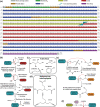TSGIT: An N- and C-terminal tandem tag system for purification of native and intein-mediated ligation-ready proteins
- PMID: 33150985
- PMCID: PMC7784762
- DOI: 10.1002/pro.3989
TSGIT: An N- and C-terminal tandem tag system for purification of native and intein-mediated ligation-ready proteins
Abstract
A large variety of fusion tags have been developed to improve protein expression, solubilization, and purification. Nevertheless, these tags have been combined in a rather limited number of composite tags and usually these composite tags have been dictated by traditional commercially-available expression vectors. Moreover, most commercially-available expression vectors include either N- or C-terminal fusion tags but not both. Here, we introduce TSGIT, a fusion-tag system composed of both N- and a C-terminal composite fusion tags. The system includes two affinity tags, two solubilization tags and two cleavable tags distributed at both termini of the protein of interest. Therefore, the N- and the C-terminal composite fusion tags in TSGIT are fully orthogonal in terms of both affinity selection and cleavage. For using TSGIT, we streamlined the cloning, expression, and purification procedures. Each component tag is selected to maximize its benefits toward the final construct. By expressing and partially purifying the protein of interest between the components of the TSGIT fusion, the full-length protein is selected over truncated forms, which has been a long-standing problem in protein purification. Moreover, due to the nature of the cleavable tags in TSGIT, the protein of interest is obtained in its native form without any additional undesired N- or C-terminal amino acids. Finally, the resulting purified protein is ready for efficient ligation with other proteins or peptides for downstream applications. We demonstrate the use of this system by purifying a large amount of native fluorescent mRuby3 protein and bacteriophage T7 gp2.5 ssDNA-binding protein.
Keywords: IPL; Intein; SUMO; biotin; fusion tag; protein cleavage; protein degradation; protein expression; protein ligation; purification tag; truncated protein.
© 2020 The Authors. Protein Science published by Wiley Periodicals LLC on behalf of The Protein Society.
Conflict of interest statement
The authors declare no conflict of interest.
Figures






Similar articles
-
Simplified cloning and isolation of peptides from "sandwiched" SUMO-peptide-intein fusion proteins.BMC Biotechnol. 2023 Apr 5;23(1):11. doi: 10.1186/s12896-023-00779-5. BMC Biotechnol. 2023. PMID: 37020212 Free PMC article.
-
Ligation-independent cloning and self-cleaving intein as a tool for high-throughput protein purification.Protein Expr Purif. 2013 Oct;91(2):169-74. doi: 10.1016/j.pep.2013.08.006. Epub 2013 Aug 19. Protein Expr Purif. 2013. PMID: 23968594 Free PMC article.
-
Ubiquitin-intein and SUMO2-intein fusion systems for enhanced protein production and purification.Protein Expr Purif. 2012 Mar;82(1):174-8. doi: 10.1016/j.pep.2011.11.017. Epub 2011 Dec 8. Protein Expr Purif. 2012. PMID: 22178731
-
Intein Based Fusion Proteins: Great Tags for the Soluble Production and Convenient Purification of Recombinant Proteins.Iran J Biotechnol. 2024 Apr 1;22(2):e3728. doi: 10.30498/ijb.2024.400460.3728. eCollection 2024 Apr. Iran J Biotechnol. 2024. PMID: 39220337 Free PMC article. Review.
-
Site-specific protein labeling by intein-mediated protein ligation.Methods Mol Biol. 2011;705:87-107. doi: 10.1007/978-1-61737-967-3_6. Methods Mol Biol. 2011. PMID: 21125382 Review.
Cited by
-
Essential factors, advanced strategies, challenges, and approaches involved for efficient expression of recombinant proteins in Escherichia coli.Arch Microbiol. 2024 Mar 12;206(4):152. doi: 10.1007/s00203-024-03871-2. Arch Microbiol. 2024. PMID: 38472371 Review.
-
Simplified cloning and isolation of peptides from "sandwiched" SUMO-peptide-intein fusion proteins.BMC Biotechnol. 2023 Apr 5;23(1):11. doi: 10.1186/s12896-023-00779-5. BMC Biotechnol. 2023. PMID: 37020212 Free PMC article.
-
Factors involved in heterologous expression of proteins in E. coli host.Arch Microbiol. 2023 Apr 29;205(5):212. doi: 10.1007/s00203-023-03541-9. Arch Microbiol. 2023. PMID: 37120438 Free PMC article. Review.
-
Mechanistic investigation of human maturation of Okazaki fragments reveals slow kinetics.Nat Commun. 2022 Nov 15;13(1):6973. doi: 10.1038/s41467-022-34751-2. Nat Commun. 2022. PMID: 36379932 Free PMC article.
-
Semi-Biosynthetic Production of Surface-Binding Adhesive Antimicrobial Peptides Using Intein-Mediated Protein Ligation.Int J Mol Sci. 2022 Dec 2;23(23):15202. doi: 10.3390/ijms232315202. Int J Mol Sci. 2022. PMID: 36499519 Free PMC article.
References
-
- Terpe K. Overview of tag protein fusions: From molecular and biochemical fundamentals to commercial systems. Appl Microbiol Biotechnol. 2003;60:523–533. - PubMed
-
- Young CL, Britton ZT, Robinson AS. Recombinant protein expression and purification: A comprehensive review of affinity tags and microbial applications. Biotechnol J. 2012;7:620–634. - PubMed
Publication types
MeSH terms
Substances
LinkOut - more resources
Full Text Sources

